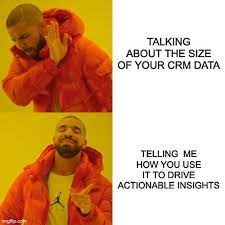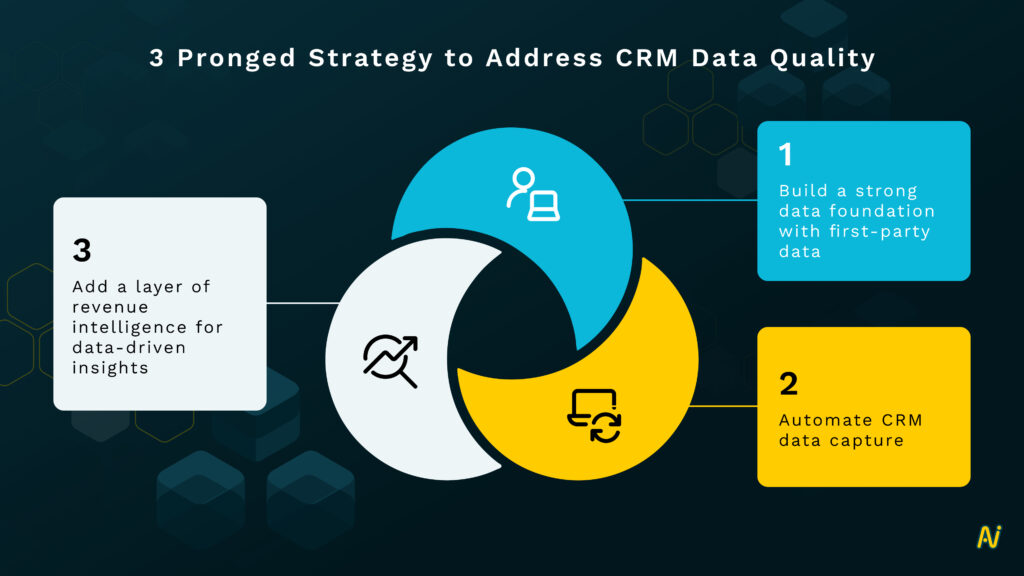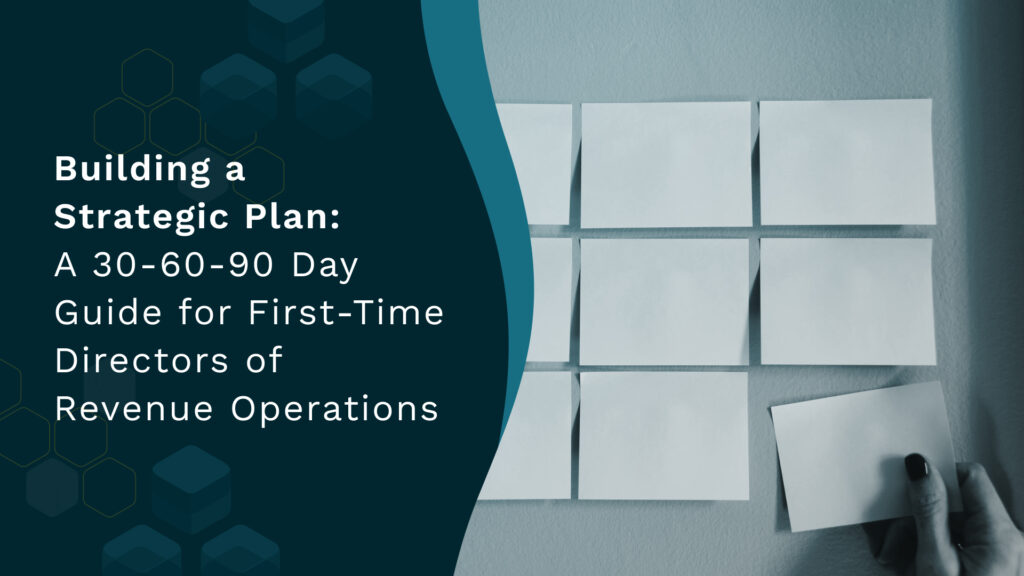
Fix Your CRM Data Quality to Drive More Revenue
Your CRM data quality has a direct impact on your sales forecasting and revenue! Get it right to drive a predictable revenue engine.
Your CRM has tons of data in it. As per a survey, organizations have an average of 250k records sitting in their CRM.
But how valuable is this data in driving the insights that can actually impact the growth of an organization?
The answer is unfortunate. Only 5% of organizations trust their CRM data to drive their go-to-market motions.

It’s not about the quantity of data in your CRM. Organizations have more data than ever and their CRMs keep getting filled up with more records with time. Marketing collects data through their campaigns, sales teams collect data through their interactions with clients, customer support captures data through calls.
It’s the quality of the CRM data that actually moves the revenue needle. The true value of a CRM can only be realized if this data is accurate and trustworthy.
Without trustworthy data in your CRM, go-to-market motions fail to deliver. Customer churn, lower morale among employees, lower ROI from your tech stacks and misalignment among the customer-facing teams lead to tremendous revenue leakage.
Having confidence in your CRM is the first step to creating a scalable and predictable revenue engine. Unfortunately, data quality continues to be a challenge for revenue leaders.
Inefficiencies are Plaguing Your CRM Data Quality
Even after more than 20 years of existence, CRMs have failed to evolve from a system of record to a system of actionable insight.
But most of this annoyance has less to do with the way CRM functions and more to do with the data with which it operates. Here are some of these data inefficiencies that are preventing your CRM from delivering the value it was intended for.
1. Missing data
With CRMs putting a burden on sales reps to manually upload data, most of it goes missing or never enters the system. This leaves out critical revenue data that translates into missed opportunities.
2. Data decay
CRM data decays at a ridiculously fast rate of 70.3% per year. This rate has accelerated at an unprecedented rate post Covid-19 as per 79% of respondents in a survey.
Using data that is no longer relevant can lead sales and marketing down the wrong paths as they end up targeting the wrong customers at the wrong time.
3. Data silos
Most data in CRMs is in silos. Sales teams have their own sets of data and marketing operates within its own tech stacks. This lack of coordination and alignment leads to both teams working on their individual goals.
Without the unification of data from multiple sources into a single source of truth, campaigns fail to deliver targeted and personalized value to buyers.
4. Poor quality data
Incorrect or outdated data sit in CRMs even as change sweeps over organizations. For example, people leave positions, companies grow out of segments, mergers and acquisitions happen, or your buyer goes for your competitor.
Knowing about these constant changes is crucial to carry out successful campaigns for your buyers. However, with stagnant CRM data, these changes never get captured.
How Poor CRM Data Quality Affects Revenue
For great results, you need to be careful of what you feed your CRM system. Or else, it becomes a classic case of “garbage in, garbage out.” You cannot expect great results from CRM insights if the source of the data in it is unreliable.

Data lies at the heart of gaining visibility on where to make improvements, drive focus on leading indicators and fix the revenue funnel before it breaks. If the data in the CRM in itself is plagued, you cannot expect insights from it that drive revenue.
In fact, it is quite the opposite. In a recent survey, 44% of respondents estimated their company loses over 10% of annual revenue due to poor data quality.
Such data inefficiencies are causing revenues to leak through your funnel in myriad ways.
Some of them include:
1. High employee turnover
CRM users aka your employees are reaching a saturation point. 64% of them say they would consider leaving their current role if organizations don’t invest resources in a CRM data quality plan. In a world where talent is scarce, employees leaving would mean so much more time and resources gone in hiring more people, onboarding them and keeping them engaged.
2. Poor sales forecasting
The quality of your sales forecast has a direct impact on your revenue. A poor sales forecast is a result of bad data fed into your systems that fail to predict how much revenue will be closed quarter after quarter. The result is wasted resources on avenues that lead to no result.
3. Poor ROI from tech stack
Revenue leaders invest in different tools as a part of their tech stack, CRM being one of them. But all these tech stacks can only deliver ROI when they have the right data to work with. Without quality data, these tech stacks will just remain as shiny objects that eat up budgets without delivering any meaningful value to revenue.
4. Poor targeting
Picking up all contacts from a CRM and running a uniform campaign for all is passe. Today’s customers want hyper-personalized messaging, which requires marketing teams access to high-quality data that tell them more about their contacts than simple name and email ids.
CRM data tells marketing teams who to target for their campaigns. It fails to address the “why.” Bad data aggravates this problem by sending wrong messages to the wrong customers for solutions they might not even be looking for, thus putting the reputation of a brand on the brink of damage.
How to Address the CRM Data Quality Issue
Having a strong data foundation is the first step to address the CRM data quality issue . Once you have a strong foundation for data capture, the next step is to ensure that you have set up a system in place that continually enriches, maintains and updates that data.
For example, if a contact in your CRM leaves the organization, there should be a way for your system to update this information in the CRM. Similarly, if a new stakeholder has joined the buying committee you’re currently pitching to, that contact must get captured in the CRM without anyone having to manually upload it.
Finally, raw data in itself is useless. Add a layer of revenue intelligence on top of high-quality CRM data to get access to data-driven insights that can help you generate more revenue for the business.
Let’s dive in:
1. Build a strong data foundation
If a lot of data comes from third-party sources, their quality and adherence to compliance can be questionable. And third-party data is gradually on their way out with laws around data access getting more stringent. Collecting data from first-party sources gets rid of this problem at its source.
First-party data is the data that your user shares directly with you. Examples include their email id, phone number, job role or other such information. This information is shared with the user’s consent. For example, through an ebook that a user voluntarily downloads, or someone who registers for one of your webinars.
This data is highly valuable as it is the result of your direct relationship with the user. First-party data is unique to you, privacy-compliant, accurate, low-cost and marketable. And using first-party data in your CRM to drive insights has proven to double revenue and increase cost savings by 1.6 times.
2. Automate CRM data capture
Forcing sales reps to manually upload contacts into CRM does not work. It never has and it never will. Not only will your CRM fill up with inaccurate and incomplete data because of manual upload, you will also lose out on sales productivity and employee morale.
Your sales reps hate being forced to spend valuable time on manual CRM upload when they could be selling to customers. Give your reps the gift of time by investing in an AI solution that automatically captures data into your CRM from internal as well as external sources. According to Gartner, CRM data capture is a perfect job for AI.
Automatic capture of data into the CRM can free up to 5 to 6 hours of sellers time per week. Automation ensures that the data is correct and not duplicated. And your sales reps do not take the CRM as a burden. Rather, they start using it as a core part of their daily activities to drive more sales.
3. Leverage actionable insights from CRM data
Raw data in itself is useless. But if you have the right data, the insights from it can be a powerful tool to drive your revenues.
Once you are sure of the quality of the data in your CRM, add a layer of revenue intelligence to it to drive actionable insights out of it. Actionable insights can be used to inform decisions, actions and conversations that help close more deals.
A powerful revenue intelligence tool can help you uncover hidden insights from your own first party data. For example, a sales rep that knows that a new CEO has joined an organization he is pitching to has more leverage than a sales rep that does not have this information. By knowing this detail, the rep is better prepared to message the new stakeholder in the buying committee, and pitch accordingly. The sales rep also knows that the old CEO is no longer a part of the buying committee and hence needs to be excluded from future conversations.
This is just one example. There are many more ways CRM data can be converted into actionable intelligence that can lead to actions that drive revenue.

Commit to a Sustainable Revenue Model With High-Quality CRM Data
Uncertainties, unpredictability and economic shocks are forcing businesses to develop processes that are iron clad and look at the big picture. Addressing the root causes of revenue leakage is the first-step to building a sustainable revenue model that can withstand the shocks of any uncertainty.
Solving your CRM data quality issue is an investment that will pay in the long run and protect your business from the shocks of any uncertainty. Make a commitment to data quality and fix the issue at the grassroot level.
Allow the power of high-quality CRM data to power your entire GTM motion and supercharge your revenue engine. Take that first step towards data quality today with Nektar.
Do a quick CRM audit to see how much data it is currently missing.
PUBLISHED BY









